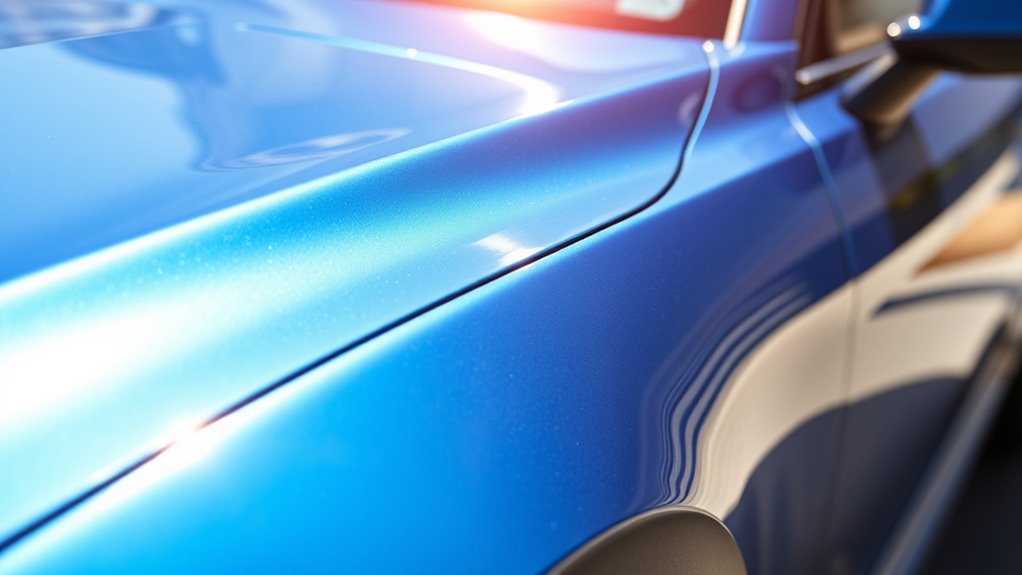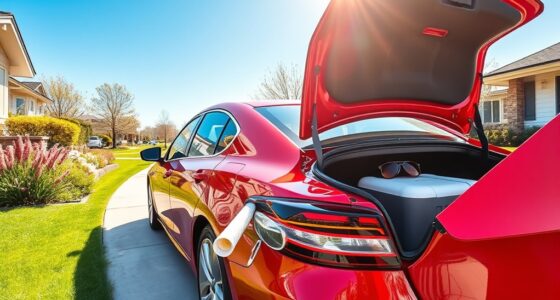To protect your car’s paint and trim in harsh sunlight, regularly apply a high-quality wax or sealant to create a protective layer that absorbs UV rays. Park in shaded areas or cover your vehicle with a breathable car cover when possible. Frequent washing with pH-balanced products, combined with clay bar treatments, helps maintain the surface. Keep in mind, investing in proper protection now will save you costly repairs later—learn more to keep your vehicle looking its best.
Key Takeaways
- Regularly apply high-quality wax or sealant to create a UV-resistant protective layer.
- Park in shaded areas or use breathable, UV-resistant car covers when parking outdoors.
- Wash your vehicle frequently with pH-balanced products to remove dirt and prevent surface damage.
- Use clay bar treatments and reapply protective coatings biannually to maintain paint integrity.
- Incorporate parking strategies and protective products into routine maintenance to minimize UV-related damage.

Have you ever wondered how to keep your car’s paint looking shiny and new? If you park outdoors regularly, harsh sunlight can quickly take a toll on your vehicle’s appearance. UV damage is one of the main culprits behind fading, oxidation, and dullness. When exposed to prolonged sunlight, ultraviolet rays penetrate the paint’s surface, breaking down the clear coat and leading to color fading over time. To combat this, you need effective paint preservation strategies that shield your car from these damaging rays and maintain its glossy finish.
Protect your car’s paint from UV rays to keep it shiny and vibrant over time.
The first step in protecting your car’s paint involves applying high-quality wax or sealant. These products create a protective barrier that reflects UV rays away from the paint surface. Regularly waxing your vehicle, ideally every three to four months, ensures consistent protection. Car wax forms a sacrificial layer that absorbs the impact of UV rays, preventing them from reaching the underlying paint. Sealants, on the other hand, tend to last longer and provide a more durable shield against environmental stressors, including sunlight. Using these products not only enhances shine but also makes it easier to wash off dirt and contaminants that can accelerate paint deterioration.
Another essential aspect of paint preservation is parking your vehicle wisely. Whenever possible, seek shaded areas or covered parking to minimize direct sun exposure. If shaded parking isn’t available, consider investing in a high-quality car cover. A good cover protects your car’s exterior from UV rays, dust, and pollutants that can compound sunlight damage. When choosing a cover, look for one made from breathable, UV-resistant materials that don’t trap moisture, which could lead to paint issues like rust or mold.
Regular washing and detailing also play significant roles in maintaining your car’s paint in harsh sunlight. Dirt, grime, and bird droppings can be abrasive and, when left on the surface, can magnify UV damage. Use gentle, pH-balanced car shampoos and soft microfiber cloths to remove these contaminants. Follow up with a clay bar treatment once or twice a year to eliminate embedded particles that can scratch or dull the paint surface. Finish with a fresh layer of wax or sealant to bolster your paint’s defenses against UV rays and environmental pollutants.
Additionally, being aware of production quantity variances can help you better understand how to manage costs and maintain quality in your vehicle care routine, ensuring your investments in protection are cost-effective and efficient.
Frequently Asked Questions
Can Natural Remedies Effectively Protect Car Paint From Sun Damage?
Natural remedies can help protect your car paint from sun damage, but they’re not as effective as commercial products. DIY remedies using natural ingredients like coconut oil or carnauba wax can provide a temporary shield and add shine. However, for long-term protection, it’s better to use specialized car waxes or sealants. Combining natural remedies with regular washing and parking in shaded areas offers the best defense against harsh sunlight.
How Often Should I Apply Protective Coatings for Optimal Sun Protection?
You should apply protective coatings every 3 to 6 months to guarantee ideal sun protection for your car. Regular application frequency helps maintain the coating’s effectiveness and extends its longevity. Factors like weather conditions and exposure levels can influence how often you need to reapply. By staying consistent with your coating routine, you’ll keep your paint shielded from UV rays and preserve its shine longer.
Are There Specific Colors More Vulnerable to Sun Damage Than Others?
Bright red or deep blue cars often seem more vulnerable to sun damage because they tend to show color fading faster. Lighter shades like silver or white usually have better UV resistance, maintaining their vibrancy longer. Imagine sunlight stripping away the richness of darker colors, while lighter hues stay more resilient. To protect your vehicle, choose paint colors with high UV resistance and regularly apply protective coatings to keep your car looking fresh.
Does Parking in the Shade Significantly Extend Paint Lifespan?
Parking in the shade considerably extends your car’s paint lifespan because it reduces sun exposure effects that cause fading and damage. Shade parking keeps your vehicle cooler and shields it from UV rays, which deteriorate the paint over time. By choosing shaded spots, you prevent rapid color fading, preserve the clear coat, and maintain your car’s overall finish longer. It’s a simple, effective way to protect your vehicle from harsh sunlight.
What’s the Best Way to Remove Stubborn Sun-Induced Paint Oxidation?
Did you know that sunlight causes up to 80% of paint oxidation on vehicles? To remove stubborn sun-induced paint oxidation, you should start with a quality clay bar or polish designed for oxidation removal. For severe cases, consider paint restoration techniques like buffing with a rubbing compound. Always follow up with a wax or sealant to protect your paint. Regular maintenance prevents future oxidation and keeps your car looking new.
Conclusion
By taking simple steps to protect your car’s paint and trim, you’re like a shield against the relentless sun’s fiery gaze. Think of your car as a precious gem, shimmering under a protective canopy that keeps its brilliance alive. With regular waxing, parking wisely, and using quality products, you preserve its luster and defend it from the harsh sunlight’s relentless assault. Keep your car shining bright, a beacon of pride in any sunlight’s glare.








